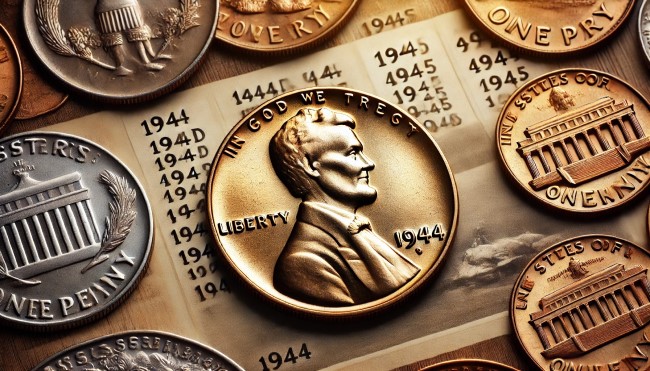1944 Wheat Penny Value: The Complete Guide to Understanding Its Worth

The 1944 wheat penny is a fascinating coin for collectors and history enthusiasts alike. While millions of these pennies were minted, several factors contribute to their varying values. Whether you’ve come across a 1944 penny in your pocket change or inherited a collection, understanding the specifics of the 1944 wheat penny value, including its different mint marks and conditions, can help you determine its worth.
Overview of the 1944 Wheat Penny
The 1944 wheat penny was produced in the United States during a time of great historical significance. As World War II raged on, the U.S. Mint reverted to using copper for pennies after the 1943 steel cents, which were made to conserve copper for the war effort. This transition back to copper in 1944 led to a few notable variations, including some extremely rare and valuable coins.
Key Factors Influencing the 1944 Wheat Penny Value
Several factors determine the value of a 1944 wheat penny:
- Mint Mark: The presence of a mint mark can significantly influence a penny’s value. The 1944 penny was minted in Philadelphia (no mint mark), Denver (D), and San Francisco (S).
- Condition: Like all coins, the condition of the penny plays a crucial role. Coins in uncirculated or mint condition are far more valuable than those showing significant wear.
- Rarity and Errors: Some 1944 pennies were struck on steel planchets (similar to the 1943 pennies) or have minting errors, making them extremely rare and valuable.
1944 S Wheat Penny Value
The 1944 S wheat penny was minted in San Francisco, with a total mintage of approximately 282 million coins. Despite the large number produced, the value of these pennies varies depending on their condition:
- G-4 (Good): $0.10
- VG-8 (Very Good): $0.15
- F-12 (Fine): $0.25
- VF-20 (Very Fine): $0.50
- EF-40 (Extremely Fine): $1.25
- AU-50 (About Uncirculated): $2.50
- MS-60 (Mint State): $10.00
- MS-63 (Mint State): $25.00
- MS-65 (Mint State): $60.00
- MS-67 (Mint State): $400.00
1944 D Wheat Penny Value
The 1944 D wheat penny, minted in Denver, is slightly more valuable than its Philadelphia counterpart, especially in higher grades. Here’s a breakdown:
- G-4 (Good): $0.10
- VG-8 (Very Good): $0.15
- F-12 (Fine): $0.25
- VF-20 (Very Fine): $0.50
- EF-40 (Extremely Fine): $1.00
- AU-50 (About Uncirculated): $2.00
- MS-60 (Mint State): $7.50
- MS-63 (Mint State): $15.00
- MS-65 (Mint State): $30.00
- MS-67 (Mint State): $200.00
1944 Steel Wheat Penny Value
One of the most coveted coins in the Lincoln wheat series is the 1944 steel penny. Only a few of these coins are known to exist, as they were struck on leftover steel planchets from 1943 by mistake. Their rarity makes them incredibly valuable:
- Circulated condition: $85,000+
- MS-60 (Mint State): $112,500
- MS-65 (Mint State): $180,000+
- MS-66 (Mint State): $373,750
1944 Wheat Penny Value Without Mint Mark
The 1944 penny without a mint mark was produced at the Philadelphia Mint. It’s the most common of the 1944 pennies, yet still holds value for collectors:
- G-4 (Good): $0.10
- VG-8 (Very Good): $0.15
- F-12 (Fine): $0.25
- VF-20 (Very Fine): $0.50
- EF-40 (Extremely Fine): $1.00
- AU-50 (About Uncirculated): $2.00
- MS-60 (Mint State): $5.00
- MS-63 (Mint State): $10.00
- MS-65 (Mint State): $20.00
- MS-67 (Mint State): $150.00
Most Valuable 1944 Wheat Penny Variants
Among the different variants, certain 1944 wheat pennies are exceptionally valuable due to their rarity or minting errors. These include:
- 1944 Steel Penny: As mentioned earlier, this is one of the rarest and most valuable variants.
- 1944 D/S Wheat Penny: This penny has the Denver mint mark (D) stamped over the San Francisco mint mark (S), making it highly sought after by collectors. It can fetch up to $8,400 in MS67+ condition.
- 1944 S Over D: Similar to the D over S, but with the mint marks reversed. This is another valuable error.
Grading and Condition: How They Impact Value
Grading is a critical aspect of determining a coin’s value. The Sheldon Scale, ranging from 1 (Poor) to 70 (Perfect Mint State), is commonly used. Here’s a brief overview of the grades:
- G-4 (Good): Heavily worn but with clear date and mint mark.
- VG-8 (Very Good): Well-worn but all major details visible.
- F-12 (Fine): Moderate wear with some detail remaining.
- VF-20 (Very Fine): Light to moderate wear, more details visible.
- EF-40 (Extremely Fine): Light wear, with sharp details and strong eye appeal.
- AU-50 (About Uncirculated): Slight traces of wear on the highest points, nearly mint condition.
- MS-60 to MS-70 (Mint State): No wear, only minor contact marks, with higher grades being more valuable.
Conclusion: Understanding the Value of Your 1944 Wheat Penny
Whether you’re a seasoned collector or a newcomer, understanding the value of your 1944 wheat penny is essential. By considering the mint mark, condition, and any potential errors, you can better gauge its worth. For the most accurate assessment, especially for rare variants, consider having your penny professionally graded.
The 1944 wheat penny holds not only monetary value but also a piece of history, making it a cherished item for collectors around the world. Keep an eye out for those rare errors and high-grade examples, as they can turn a simple penny into a significant investment.

